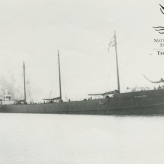Madeira – Schooner Barge 1900 – 1905 (SHIPWRECK)
Madeira – Schooner Barge 1900 – 1905 (SHIPWRECK)
split rock, mn
The Madeira was built and launched at the Chicago Yard of the Chicago Shipbuilding Company in 1900. It had a plate keel and was shaped very flat and full to maximize cargo capacity with minimum draft. The vessel was built to carry bulk cargoes of grain, lumber or iron ore economically about the Great Lakes and on the coasts, under tow of a steam powered freighter. The shipwreck Madeira is historically significant as the best and one of the few known surviving examples of a schooner-barge. Though the Madeira was lost in a violent storm and is broken into numerous pieces scattered about the lake bottom, the major diagnostic elements of the hull are relatively intact. The Madeira’s value is enhanced by its relationship to Split Rock Lighthouse, which was built partially because of the Madeira’s loss. The remains of the Madeira were listed on the National Register of Historic Places in 1992.
Storm
The Madeira was in ballast and under tow of the steamer William Edenborn on Nov. 28, 1905 in the midst of the worst storm in the history of the Great Lakes. At approximately 3:30 a.m., the captain of the Edenborn, fearing for the safety of his ship and consort, cut the Madeira’s towline. He apparently believed that the Madeira stood a better chance of staying afloat if it cast anchor and tried to ride out the storm. Although the accounts of the Madeira’s loss reported in contemporary newspapers suggest that it attempted to cast anchor, divers found both anchors intact on the bow.
The Madeira struck Gold Rock, north of the present location of Split Rock Lighthouse, at approximately 5:30 a.m. At about the same time, the Edenborngrounded and broke in two, four miles away near the community of Split Rock. As the Madeira’s hull pounded broadside against the rocky cliff, the ship began to break up. The Madeira’s 10-man crew would most likely have perished, had not Fred Benson, a Scandinavian crewman, grabbed a line and jumped from the deck of the ship to a rock outcrop at the base of the cliff. Then, with stormy seas crashing against him, Benson climbed the 60-foot cliff to the top. From there he dropped his line, weighted down with a rock, to the deck of the Madeira’s bow section, rescuing the three men trapped there. Then he dropped the line onto the stern deck, and five more men climbed to safety. Only one man lost his life in the wreck. The first mate was carried down with the sinking ship as he climbed the mizzenmast in an attempt to jump to safety. The survivors, suffering from exposure, were rescued two days later by the tug Edna G., which also recovered the body of the mate. Fred Benson was singled out as the hero of the storm in the Duluth newspaper.
The Madeira was one of 20 vessels wrecked or damaged during the Mataafa Storm. Of those vessels, however, only a handful, including the Madeira were total losses. Of all the Great Lakes, Lake Superior recorded the greatest loss of life and property from the storm. Property loss from the Mataafa Storm was estimated at $1.75 million. Rather than alter the economical design of its ships or underwrite an exorbitantly expensive insurance policy upon them, the Pittsburgh Company launched a campaign for the cheapest available protection, a government financed light station. After heavy lobbying by transportation interests, and partially as a result of the loss of the Madeira, Split Rock Lighthouse was erected within sight of the wreck in 1910. A history of Split Rock Lighthouse compiled by the Minnesota Historical Society notes that Split Rock Lighthouse clearly owes its existence to the storm, although it is inconceivable that a lighthouse could have averted such a disaster.
Remains Can Be Seen From Shore
The remains of the Madeira lie broken and scattered in several large sections and numerous small pieces around Gold Rock cliff, immediately north of Split Rock Lighthouse on Lake Superior. Water visibility varies from 20 to 60 feet in both shallow and deeper areas of the site. Water depths range from 15 to over 100 feet. Madeira’s wreckage covers a varied topography. A boulder-strewn slope begins at the base of Gold Rock cliff in approximately 10 feet of water, ending at varying depths where the bottom is composed of gently sloping sand.
Madeira Detailed Information
MN historical Society Shipwreck Map
All Content the property of MN Historical Society and Sources. Photo the property of Eric Swanson, Mpls MN.




